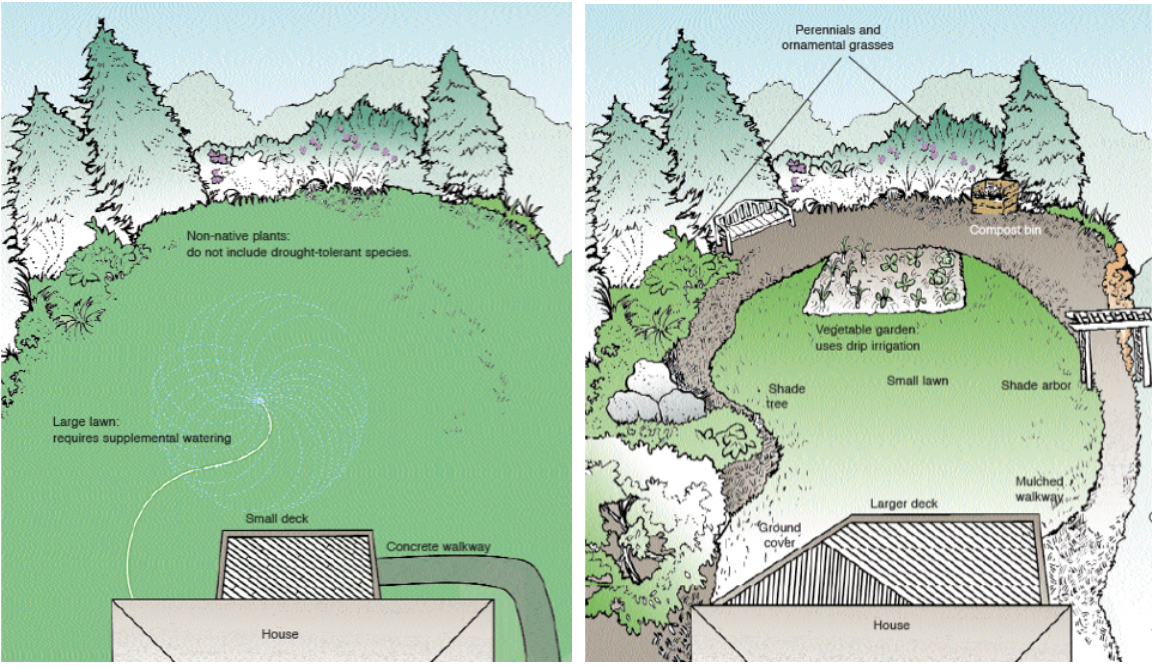Water-Efficient Landscaping
New ResidentialWhat is Water-Efficient Landscaping?
Water-efficient landscaping refers to several different terms, such as water-wise, water-smart low-water, and natural landscaping that all rely on the same basic principles.[1] Xeriscape landscaping, for example, includes landscaping that conserves water and protects water quality by utilizing landscape designs and plantings suited to local conditions. Most water efficient landscaping approaches incorporate the following suggestions:[2]
- Group plants according to their watering needs.
- Use native and adapted plants (see Native and Adapted Plants).
- Limit turf areas (see Turf Grass Reduction).
- Use efficient irrigation systems and watering schedules (see Smart Sensors and Controls).
- Start with healthy soil and add mulch to retain moisture.
- Provide regular maintenance.
The US EPA estimates that the average family of four uses about 400 gallons of water per day, 30 percent for outdoor use. Landscape irrigation accounts for more than one-third of all residential water use nationwide. Water use depends on location and climate, but in some areas, up to 50 percent of water used to irrigate may be lost to evaporation, wind, and improper system design or overwatering.[3] Minimizing or eliminating the use of potable water for irrigation can conserve clean water for the benefit of the environment and the community.

Figure 1 – Non-Xeriscaping (left) and Xeriscaping (right) (Source: US EPA – Water Efficient Landscaping)
How to Implement Water-Efficient Landscapes
Design landscapes that rely on natural rainfall and only require supplemental irrigation during the plants’ initial establishment period. Use native and appropriate non-native vegetation adapted to site conditions and climate (see Native and Adapted Plants). Group plants with similar water requirements to maximize irrigation efficiency and use climate-based controllers for irrigation systems to lower water consumption. Consider using non-potable water for irrigation (see Rain Barrels and Cisterns, and Onsite Alternative Water Reuse).[4]
For more information, refer to US EPA’s WaterSense Water-Smart Landscaping Design Guide.
For location specific information, refer to your county extension service, and local garden and nursery centers.
Benefits
Economic:
- Lowers water bills – careful design and choice of appropriate plants can reduce outdoor water use by 20 to 50 percent.[5]
- Increases home values – attractive, water-efficient landscaping may increase property values.
- Saves money spent on landscape maintenance because many water-efficient plants require less care.
- Reduces tax burden by reducing stress on the municipal water infrastructure.
Environmental:
- Conserves natural resources.
- Protects against habitat loss and increases biodiversity by introducing native plants
- Lowers energy use due to less pumping and treatment of water.
- Reduces stormwater and irrigation runoff that transport top soils and pollutants into waterways.
Personal Wellness:
- Saves time spent on landscaping.
Costs
The cost of water-efficient landscaping does not exceed the cost of conventional landscaping. The cost and cost-savings of water-efficient landscaping vary depending on the local cost of water. Converting irrigated turf lawns to ground covers or mulched areas can result in considerable cost savings. Changing watering schedule and landscape management without making any physical changes in the landscape may save water. A study by the UGA Cooperative Extension notes that converting 1,000 square feet of irrigated area to a non-irrigated area may save up homeowners an estimated minimum of $60 per year.[6]
Incentives for homeowners may be available through the US EPA’s WaterSense program. The program assists homeowners in improving water efficiency and reducing costs by promoting efficient irrigation technologies such as weather-based irrigation controllers and soil moisture sensors.
Resiliency
Water-efficient landscaping increases resiliency by decreasing the reliance and stress on municipal water infrastructure and supply, and by supporting local ecosystems that are drought tolerant (see Emergency Water Supply and Storage).
[1] US EPA. Water-Efficient Landscaping: Preventing Pollution & Using Resources Wisely. https://www3.epa.gov/npdes/pubs/waterefficiency.pdf (accessed March 22, 2018).
[2] US EPA. Water-Efficient Landscaping: Preventing Pollution & Using Resources Wisely. https://www3.epa.gov/npdes/pubs/waterefficiency.pdf (accessed March 22, 2018).
[3] US EPA. Outdoor Water Use in the United States. Link (accessed April 15, 2018).
[4] Dr. Steve Windhager, University of Texas School of Architecture. Sustainable Sites https://soa.utexas.edu/sites/default/disk/urban_ecosystems/urban_ecosystems/09_03_fa_windhager_calaci_ml.pdf (accessed April 15, 2018).
[5] US EPA. Outdoor Water Use in the United States. Link (accessed April 15, 2018).
[6] UGA College of Agricultural and Environmental Sciences Cooperative Extension. A Guide to Developing a Water-Wise Landscape https://athenaeum.libs.uga.edu/bitstream/handle/10724/12344/B1073.pdf?sequence=1&isAllowed=y (accessed April 15, 2018).
